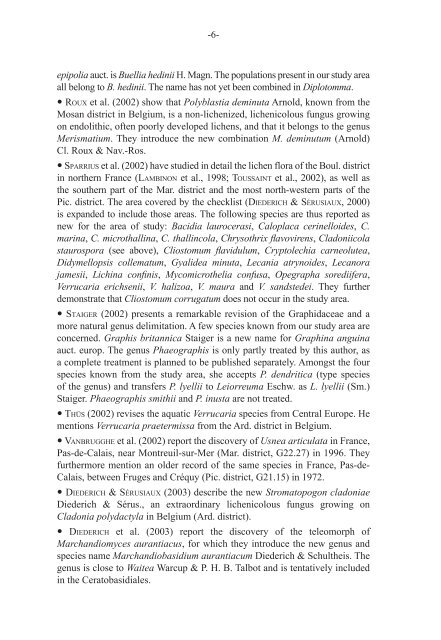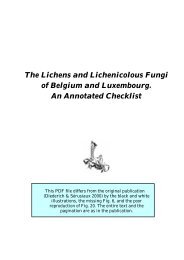LEJEUNIA - Lichens of Belgium, Luxembourg and northern France
LEJEUNIA - Lichens of Belgium, Luxembourg and northern France
LEJEUNIA - Lichens of Belgium, Luxembourg and northern France
Create successful ePaper yourself
Turn your PDF publications into a flip-book with our unique Google optimized e-Paper software.
-6-<br />
epipolia auct. is Buellia hedinii H. Magn. The populations present in our study area<br />
all belong to B. hedinii. The name has not yet been combined in Diplotomma.<br />
ROUX et al. (2002) show that Polyblastia deminuta Arnold, known from the<br />
Mosan district in <strong>Belgium</strong>, is a non-lichenized, lichenicolous fungus growing<br />
on endolithic, <strong>of</strong>ten poorly developed lichens, <strong>and</strong> that it belongs to the genus<br />
Merismatium. They introduce the new combination M. deminutum (Arnold)<br />
Cl. Roux & Nav.-Ros.<br />
SPARRIUS et al. (2002) have studied in detail the lichen flora <strong>of</strong> the Boul. district<br />
in <strong>northern</strong> <strong>France</strong> (LAMBINON et al., 1998; TOUSSAINT et al., 2002), as well as<br />
the southern part <strong>of</strong> the Mar. district <strong>and</strong> the most north-western parts <strong>of</strong> the<br />
Pic. district. The area covered by the checklist (DIEDERICH & SÉRUSIAUX, 2000)<br />
is exp<strong>and</strong>ed to include those areas. The following species are thus reported as<br />
new for the area <strong>of</strong> study: Bacidia laurocerasi, Caloplaca cerinelloides, C.<br />
marina, C. microthallina, C. thallincola, Chrysothrix flavovirens, Cladoniicola<br />
staurospora (see above), Cliostomum flavidulum, Cryptolechia carneolutea,<br />
Didymellopsis collematum, Gyalidea minuta, Lecania atrynoides, Lecanora<br />
jamesii, Lichina confinis, Mycomicrothelia confusa, Opegrapha sorediifera,<br />
Verrucaria erichsenii, V. halizoa, V. maura <strong>and</strong> V. s<strong>and</strong>stedei. They further<br />
demonstrate that Cliostomum corrugatum does not occur in the study area.<br />
STAIGER (2002) presents a remarkable revision <strong>of</strong> the Graphidaceae <strong>and</strong> a<br />
more natural genus delimitation. A few species known from our study area are<br />
concerned. Graphis britannica Staiger is a new name for Graphina anguina<br />
auct. europ. The genus Phaeographis is only partly treated by this author, as<br />
a complete treatment is planned to be published separately. Amongst the four<br />
species known from the study area, she accepts P. dendritica (type species<br />
<strong>of</strong> the genus) <strong>and</strong> transfers P. lyellii to Leiorreuma Eschw. as L. lyellii (Sm.)<br />
Staiger. Phaeographis smithii <strong>and</strong> P. inusta are not treated.<br />
THÜS (2002) revises the aquatic Verrucaria species from Central Europe. He<br />
mentions Verrucaria praetermissa from the Ard. district in <strong>Belgium</strong>.<br />
VANBRUGGHE et al. (2002) report the discovery <strong>of</strong> Usnea articulata in <strong>France</strong>,<br />
Pas-de-Calais, near Montreuil-sur-Mer (Mar. district, G22.27) in 1996. They<br />
furthermore mention an older record <strong>of</strong> the same species in <strong>France</strong>, Pas-de-<br />
Calais, between Fruges <strong>and</strong> Créquy (Pic. district, G21.15) in 1972.<br />
DIEDERICH & SÉRUSIAUX (2003) describe the new Stromatopogon cladoniae<br />
Diederich & Sérus., an extraordinary lichenicolous fungus growing on<br />
Cladonia polydactyla in <strong>Belgium</strong> (Ard. district).<br />
DIEDERICH et al. (2003) report the discovery <strong>of</strong> the teleomorph <strong>of</strong><br />
March<strong>and</strong>iomyces aurantiacus, for which they introduce the new genus <strong>and</strong><br />
species name March<strong>and</strong>iobasidium aurantiacum Diederich & Schultheis. The<br />
genus is close to Waitea Warcup & P. H. B. Talbot <strong>and</strong> is tentatively included<br />
in the Ceratobasidiales.





